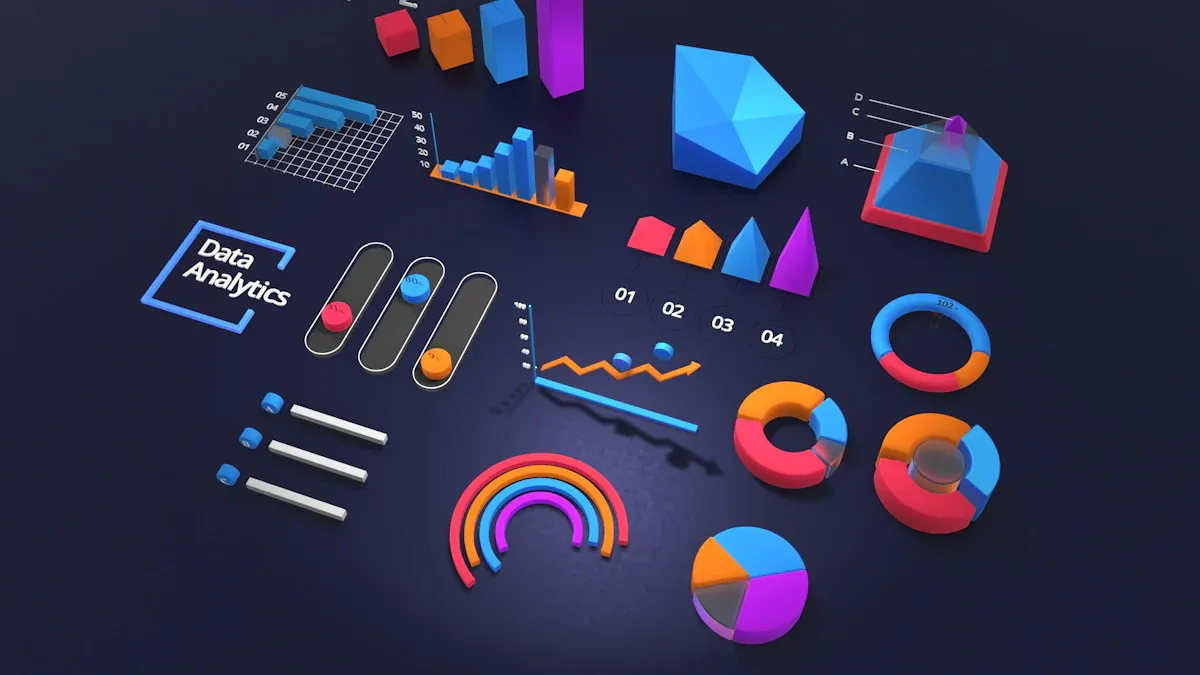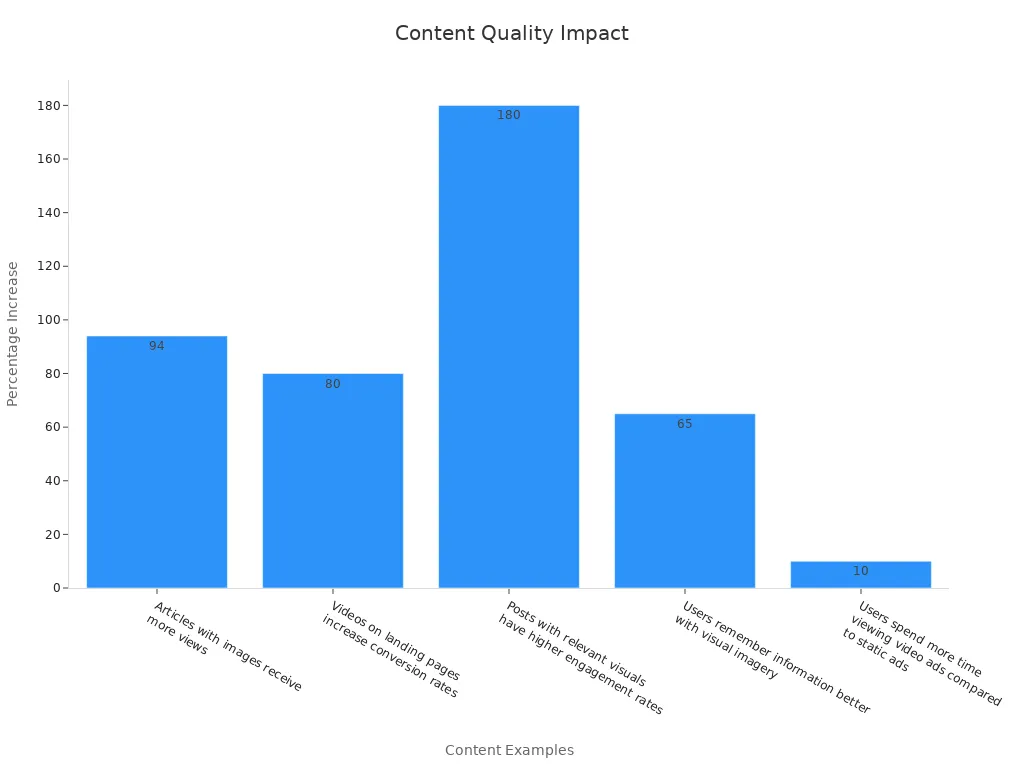How AI Predicts Content Success

AI predicts how well your content will do by finding patterns in data and analyzing how people act. It looks at trends using tools like machine learning and natural language processing. These tools help you predict how your content might perform. For example, AI predicts the best times to post by studying past engagement data. It also spots seasonal trends, allowing you to adjust your plan for better results.
AI tools don’t just save time—they help you stay ahead. About 75% of marketers think AI predicts an advantage for them. Additionally, 83% of marketers using AI say they get more done. By leveraging AI, you can create content that connects with your audience and garners more attention.
Key Takeaways
AI predicts content success by studying data and audience actions.
To measure success, track things like clicks and shares.
AI tools help find the right audience, boosting clicks and sales.
It improves content by giving tips based on past results.
AI is helpful, but people add feelings that AI cannot create.
Defining Content Success
What Content Success Means
Content success shows how well your content meets its goals. These goals might include getting more audience interaction or boosting sales. Good content connects with people, makes them engage, and serves its purpose. For example, great content often keeps readers for over 88 seconds, showing strong interest. Also, content that ranks high on search engines shows quality and trust. This matches Google's focus on expertise and reliability.
You can also see success by how it affects decisions. About 73% of B2B buyers use content to help them decide what to buy. This proves that good content can directly impact business results. In the end, success means making content that grabs attention and gives value to your audience.
Why Content Performance Prediction Matters
Predicting how content will do helps you plan better. AI tools study old data, find patterns, and guess future results. This helps you focus on making content your audience will like. For example, AI finds what makes content successful, saving time and effort.
By learning how your audience acts, you can make content they enjoy. Predictive tools also help you improve over time. As new data comes in, AI updates its guesses, keeping your plans effective. This leads to better engagement, more sales, and higher returns for your campaigns.
Metrics for Measuring Success
To know if your content works, track certain numbers. These numbers show how well your content meets your goals. Important metrics include:
Engagement rates, like likes, shares, and comments, showing audience interest.
Conversion rates, showing how many people take actions, like buying or signing up.
Traffic from your content, showing how far it reaches and who sees it.
Visuals are also key to content success. For instance, articles with pictures get 94% more views. Videos on landing pages boost conversions by 80%. Tweets with pictures get 150% more retweets, proving visuals help a lot.

Watching these numbers helps you check your content’s success and improve your plans for better results.
AI Technologies for Content Prediction

Machine Learning in Content Prediction
Machine learning helps AI guess how content will perform. It uses computer programs to study big sets of data. These programs find patterns to predict audience actions and best posting times. They also suggest the type of content your audience might like.
But machine learning has some limits. A study showed it is less accurate than older methods for predicting time-based data. It also needs more computer power, making older methods better for some tasks. Even with these issues, machine learning keeps improving and gives useful tips for better content plans.
Natural Language Processing for Audience Insights
Natural Language Processing (NLP) helps you learn what your audience likes. It studies text like social media posts, reviews, and comments. NLP turns this information into helpful ideas for making better content.
For example, the Atlanta Hawks used NLP to study online chats. They found details that numbers couldn’t show. This helped them test different ideas and improve audience feelings about their brand. NLP makes hard data easy to understand, so marketers can follow trends without needing special skills.
Predictive Analytics and Trend Identification
Predictive analytics finds new trends by studying audience data. It uses AI to look at how people interact with content and find patterns.
Here’s how predictive analytics works:
AI studies the data to find repeated patterns.
Models guess future audience actions and likes.
These models can spot changes in usual patterns, showing new trends. They also find hidden links between things, helping you see trends across areas. Using predictive analytics lets you stay ahead and make content that fits what your audience wants.
Practical Applications of AI in Content Strategy
AI-Powered Audience Targeting
AI tools change how you connect with your audience. They study lots of data to find patterns in behavior and preferences. This helps you create campaigns that match specific groups. For example, AI divides your audience into smaller groups. This ensures your content reaches the right people at the best time.
The results of AI audience targeting are clear:
Company | Improvement Type | Statistic | Year |
|---|---|---|---|
Adidas | Conversion Rates | 2022 | |
Salesforce | Customer Segmentation | 15 times better audience groups | 2022 |
Epsilon | Engagement Rate | 38% higher engagement | 2021 |
Cost per Acquisition | 30% lower costs | 2022 | |
Adore Me | Return on Ad Spend | 30% better ad returns | 2021 |
Aberdeen Group | Marketing Response Rate | 37% better campaign responses | 2022 |
Starbucks | Customer Response Rates | 3x more customer responses | 2021 |
These numbers show how AI improves audience engagement and campaign results. Using AI for streaming platforms can make your content strategy even stronger.
Content Optimization with AI
AI tools help improve your content for better results. They study engagement, search rankings, and clicks to find areas to fix. For example, AI suggests keywords, titles, and images your audience will like.
Benefits of AI content optimization include:
Cost Savings: Automating tasks like writing and research saves money.
Efficiency Gains: AI speeds up blog writing and email drafting, freeing time for planning.
Performance Metrics: Ahrefs saw 65% more article traffic using AI tools.
AI also customizes content based on user actions. For example, it recommends shows on streaming platforms that match viewer interests. This personalization boosts engagement and strengthens your strategy.
Forecasting Trends Using AI
AI is great at guessing future trends to keep you ahead. It studies past data and current patterns to find new topics and interests. This helps you make timely content that grabs attention.
Here’s how AI predicts trends:
AI reads news and social posts to spot behavior changes.
Alerts track data for updates, giving instant insights.
Models mix machine learning and statistics for better guesses.
For example, marketers used Perplexity AI to find trends like "micro-workouts." This helped them create content that matched audience interests. Neural networks adjust to new data, keeping predictions accurate.
Using AI in your strategy lets you plan for market needs, make engaging content, and stay competitive.
Challenges and Limitations of AI Content Prediction
Data Quality and Reliability
AI depends on data to predict content success. However, bad data can cause problems. Collecting data from many places may lead to errors. These mistakes make predictions less accurate. Labeling data by hand takes time and can be wrong. This creates unreliable results.
Keeping data safe is also hard. Hackers might change or steal your data, causing issues. Weak rules for managing data can make things worse. Some people may add fake data to trick AI systems. This is called data poisoning and harms predictions. Using too much fake data can also weaken AI models over time.
Tip: Use strong rules and safe storage to protect your data.
Ethical Concerns in AI Predictions
AI predictions bring up ethical questions. Privacy problems happen when data is used without permission. AI can also be unfair, showing bias that hurts your brand. If AI decisions are unclear, people may lose trust.
Personalized content is helpful but must respect privacy. You need to balance custom content with protecting user information. Clear rules are needed to make sure AI acts responsibly.
Note: Always get permission and explain how AI works to build trust.
Balancing AI Automation with Human Creativity
AI is great at doing boring tasks fast. It also studies big sets of data quickly. But AI cannot replace human creativity. Instead, it helps people create better ideas. For example, tools like Copilot suggest ideas you can improve. In game design, AI art supports human work instead of replacing it.
Interaction Level | Human Role | AI Role |
|---|---|---|
Level 2 | Sets creative goals and limits | Handles complex calculations |
Level 3 | Main source of creative ideas | Boosts human creativity |
People-made content connects emotionally with audiences. AI makes tasks easier, but human creativity is unique and valuable.
Tip: Let AI handle big data tasks so you can focus on making great content.
AI is changing how we guess content success. It saves time, boosts creativity, and makes marketing more personal. With AI tools, you can make content your audience loves.
Main advantages include:
Better personalization in ads
Adding value to industries
Year | Market Value (in Trillions) | Growth Rate (%) | Economic Impact (in Trillions) |
|---|---|---|---|
2023 | 0.208 | N/A | N/A |
2030 | 1.8 | 36.6 | 15.7 |
Even with issues like bad data and fairness worries, AI’s future in content looks bright. Companies using AI can work 80% faster and stay ahead in a fast-changing world.
Tip: Use AI to meet audience needs and succeed in your content plans.
FAQ
What does AI do to predict content success?
AI studies how people act and finds patterns in data. It guesses how your content will do and helps make plans better. AI also helps create content that connects with your audience.
How does AI help with OTT content strategies?
AI makes OTT platforms better by giving personal suggestions. It looks at what viewers like and guesses future trends. This helps platforms show content people enjoy, boosting interest and keeping viewers longer.
Can AI take over human creativity in making content?
AI helps with ideas but doesn’t replace human creativity. It handles boring tasks and gives helpful tips. This lets people focus on making unique and emotional content.
What problems does AI face in predicting content success?
AI needs good data to work well. Bad data can cause mistakes. It can also be unfair or face ethical issues like privacy concerns. AI works best with human help for emotional tasks.
How can businesses start using AI to predict content success?
Businesses can use AI tools to study audience data and improve content. These tools help guess trends and make plans better. Start small and grow as you see good results.
See Also
How AI Content Marketing Influences Digital Advertising Strategies
The Connection Between AI Utilization and Future Content Creation
Techniques To Avoid Google Detection of AI-Generated Content

